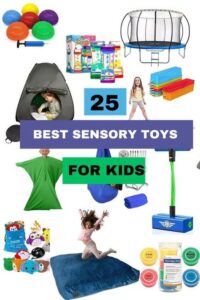
Is your child constantly seeking sensory input, leaving you feeling overwhelmed by their unpredictable and sometimes chaotic behavior? If so, you’re not alone.
Sensory seeking behavior can be a challenge to manage, but with the right strategies, it is possible to transform chaos into calm.

Hi! My name is Marra, and I am a mama of a sweet toddler and a pediatric occupational therapist. I’ve spent years working with children of all ages with different developmental needs to meet their goals and do big things while supporting the needs of their families.
The majority of children I worked with had sensory needs, and I love working with their families and caregivers to educate them on sensory processing and their child’s sensory needs as well as collaborate with them on strategies they could implement at home to make life a little easier for their child and family.
In this article, we will explore the practical techniques and expert tips that can empower parents, caregivers, and professionals in decreasing sensory-seeking behavior.
From understanding the root causes to creating a calming environment and collaborating with professionals, we will provide a comprehensive roadmap to help you navigate this journey.
By implementing these proven strategies, you can make a significant difference in helping your child thrive. So, let’s dive in and discover how you can create a calm and harmonious environment that supports their unique needs.
But first, we need to take a deeper look at sensory processing and sensory seeking behaviors.
What is Sensory Processing?
Sensory processing occurs when we take in information from our environment, try to filter out what is important and we need to attend to and what isn’t, and then choose and appropriate response to the input.
We have 8 sensory systems that we receive sensory input through. We have the 5 more commonly known sensory systems: sight, sound, smell, taste, and touch. We also have 3 additional sensory systems that are less known.
Our vestibular sense is our response to movement. It helps us stayed balance while we move around. Our proprioceptive sense is located in our muscles and joints and it is our sense of deep pressure and body awareness. Interoception is the sense of how our body is feeling.
If you would like to learn more about our 8 sensory systems check out What is Sensory Processing?

Understanding sensory seeking behaviors
To effectively address sensory seeking behavior in children, it is crucial to have a solid understanding of what it entails. Sensory seeking behavior refers to the constant search for sensory input and stimulation.
This can manifest in various ways, such as seeking out loud noises, spinning in circles, touching objects excessively, or seeking deep pressure through activities like crashing into furniture or jumping off high surfaces.
It’s important to recognize that sensory seeking behavior is not a conscious choice or an attempt to be disruptive. Instead, it is a natural response to a neurological difference in the way individuals process and respond to sensory information from their environment.
Some children simply have a higher threshold for sensory input, requiring more intense or frequent sensations to satisfy their sensory needs. They need sensory input the same way they need food and water.
Understanding the root causes behind sensory seeking behavior is an essential step in managing it effectively. Generally, sensory seeking behavior can be attributed to an imbalance in the sensory processing system.
This imbalance may be rooted in sensory processing disorder (SPD), attention deficit hyperactivity disorder (ADHD), autism spectrum disorder (ASD), or other neurological conditions.
By comprehending the underlying factors driving sensory seeking behavior, parents, caregivers, and professionals can approach it with empathy and develop targeted strategies to address their child’s unique needs.
A key aspect of understanding is recognizing that sensory seeking behavior is not a deliberate act of defiance or disobedience, but rather a coping mechanism or a way for the child to regulate their sensory system.

Recognizing the signs and triggers of sensory seeking behavior
The impact of sensory seeking behavior can vary from one child to another. Some children may display mild sensory seeking behavior that is manageable and doesn’t significantly interfere with their daily lives.
However, for others, sensory seeking behavior can be overwhelming and lead to challenges in various areas, including social interactions, academic performance, and emotional well-being.
Ultimately, understanding sensory seeking behavior is crucial in order to provide the right support and create an environment that fosters calm and harmony.
By recognizing the root causes and the unique sensory needs of the child, parents and caregivers can tailor their approach, seek appropriate professional guidance, and implement effective strategies to help their child thrive.
With this knowledge as a foundation, the subsequent section will delve into recognizing the signs and triggers of sensory seeking behavior, further equipping you with valuable insights to navigate this complex journey.
Recognizing the signs and triggers of sensory seeking behavior is an essential step in effectively managing and supporting a child with these needs. Although every child is unique, there are common indicators that can help identify sensory seeking behaviors.
These signs may include constantly seeking movement or pressure, such as jumping or crashing into objects, difficulty sitting still or remaining focused, an insatiable need for sensory stimulation, or a tendency to engage in repetitive or self-stimulatory behaviors.
Triggers, on the other hand, refer to the specific stimuli or situations that can elicit sensory seeking behavior in a child. These triggers can vary widely and may include loud noises, bright lights, crowded environments, certain textures, or even specific smells.
What happens is that the child is receiving a triggering sensory input that they either do not like or has difficulty processing. The sensory seeking behavior is the response to help them cope with the trigger.
This is very common for children who seek proprioceptive sensory input or deep pressure (crashing, jumping, using to much force). The proprioceptive sensory input is calming to the body and helps us process other sensory input.
When a child is triggered by an unwanted sensory input, they then seek out deep pressure as a tool to help them process the sensory input and help calm their body. This is why it is so important that when we are working with a child with sensory needs and trying to help them, we respect their bodies and their voices.
Recognizing both the signs and triggers of sensory seeking behavior enables parents and caregivers to better understand the underlying needs of the child.
This knowledge empowers them to make informed decisions and create an environment that minimizes triggers while providing appropriate outlets for sensory seeking.
By being proactive in recognizing and addressing these signs and triggers, parents and caregivers can effectively manage sensory seeking behavior and foster a calmer, more supportive environment for their child.
With a solid understanding of the signs and triggers in place, let’s delve into proven strategies for managing sensory seeking behavior.
These strategies build upon the insights gained from recognizing the signs and triggers, offering practical guidance and actionable steps that can be implemented to support the child in their sensory seeking journey.
By combining this knowledge with the right strategies, parents and caregivers can help their child thrive and navigate the complexities of sensory seeking behavior with confidence.
Strategies to manage sensory seeking behavior
Recognizing both the signs and triggers of sensory seeking behavior enables you as parents and caregivers to better understand the underlying needs of the child.
This knowledge empowers you to make informed decisions and create an environment that minimizes triggers while providing appropriate outlets for sensory seeking.
By being proactive in recognizing and addressing these signs and triggers, it is possible to effectively manage sensory seeking behavior and foster a calmer, more supportive environment for your child.
Creating a calm environment
In order to create a calming environment for a child with sensory seeking behavior, it is important to consider a few key strategies.
First, providing a designated sensory space can offer a safe and calming environment for the child to engage in their sensory seeking activities.
This can be a specific room or area that is equipped with various sensory tools and materials, such as fidget toys, weighted blankets, or soft lighting.
Creating a designated space allows the child to have a dedicated area where they can explore and satisfy their sensory needs.
Sensory Diets
Another effective strategy is to incorporate sensory breaks throughout the day by implementing a sensory diet.
These breaks can be short periods of time where the child engages in sensory activities that are calming to them, such as swinging, deep pressure exercises, or listening to calming music.
By implementing a sensory diet and scheduling regular sensory breaks, parents and caregivers can help prevent sensory overload and provide the child with opportunities to self-regulate and reset their sensory system.
Additionally, incorporating sensory input into daily routines can help manage sensory seeking behavior.
For example, during meals, providing foods with different textures or allowing the child to use special utensils for tactile feedback can help fulfill their sensory needs while promoting healthy eating habits.
Similarly, incorporating sensory activities into playtime, such as using textured playdough or engaging in water play, can provide the child with sensory input while facilitating their development and enjoyment.

Heavy Work Activities
If you have a child who seeks out deep pressure as we’ve discussed before Heavy Work Activities are amazing for helping them to meet this need. These activities provide them with tons of that deep pressure they are seeking in a safe and structured way.
Check out the post below for more details on heavy work activities.
By implementing these proven strategies for managing sensory seeking behavior, you can create a calm and supportive environment that meets the child’s sensory needs.
These strategies work in harmony with the understanding of signs and triggers, empowering you to effectively support their child’s sensory seeking journey.

Empowering Parents and Caregivers
One of my favorite parts about my job is empowering parents and caregivers. You hold so much power to elicit change because you are with your child the most and no one knows your child better than you.
You as the parent or caregiver play a pivotal role in the journey of managing sensory seeking behavior. By staying informed and actively engaging with their child’s needs, you have the power to make a significant impact on their well-being.
I want to provide you with as much knowledge and resource as I can about sensory processing but at the end of the day you know what works best for your child and family.
collaborating with professionals to address sensory seeking behavior
Collaborating with professionals is a crucial step in achieving lasting results for children with sensory seeking behavior.
This post is intended to be an introduction to sensory seeking behaviors and is not the solution or a quick fix. Every child is unique and has unique sensory needs. This is why collaborating with a professional is so important.
While you, as the parents and caregivers, are undoubtedly the experts on their child, professionals bring a wealth of knowledge and experience in understanding and addressing sensory challenges.
By working together, you and professionals can create a multi-faceted approach that addresses the unique needs of your child and maximizes their potential for growth and development.
Occupational therapists are often at the forefront of professional collaboration for sensory seeking behavior. We are trained to assess and address sensory challenges, developing individualized plans to help children improve their ability to process and respond to sensory stimuli.
They may use a range of techniques and interventions, such as sensory diets, therapeutic listening, or play-based activities, tailored to each child’s specific needs.
Through regular sessions and ongoing support, occupational therapists can guide parents and caregivers in implementing strategies that will have a lasting impact on their child’s sensory seeking behavior.
In addition to occupational therapists, sensory integration specialists bring a unique perspective and expertise to the table. We use a holistic, client-centered approach to focus specifically on the integration of sensory information and the impact it has on a child’s overall functioning.
OTs work closely with parents and caregivers to develop strategies that promote optimal sensory processing, helping the child better regulate their responses to sensory input. By collaborating with sensory integration specialists, you will gain valuable insights and tools to support their child’s sensory seeking journey.

Collaboration with professionals will not only provide you with expert guidance but also offers a supportive network of individuals who understand the challenges and triumphs that come with sensory seeking behavior.
These professionals can recommend additional resources, connect families with support groups, or provide referrals to other specialists if needed. Together, you, and professionals form a team that works towards a common goal: helping the child thrive in their sensory seeking journey.
Understanding and effectively managing sensory seeking behavior in children is a crucial skill for parents, caregivers, and professionals.
By recognizing the signs and triggers, implementing proven strategies, and creating a calming environment, we can make a significant difference in helping these children thrive.
It’s not just about taming the chaos; it’s about empowering them to navigate a world that can feel overwhelming. As we collaborate with professionals and seek ongoing support, we can create a harmonious environment that supports their unique needs.
Remember, action is key. Take that first step today and unlock the potential for a lifetime of calm and success. After all, every child deserves to be seen, heard, and understood.
Please reach out with any questions or comments.


